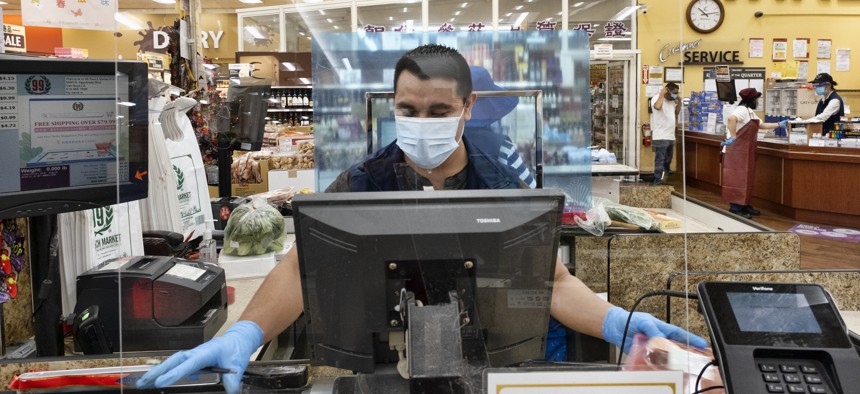The Underemployment Crisis

A grocery store worker checks out customers in Los Angeles. AP Photo
COMMENTARY | Even before the pandemic, roughly one in 10 workers wanted to log more hours.
Nannies asked to come back for two days a week instead of four. Checkout workers scheduled for 15 hours a week instead of 30. Retail employees with their shifts cut in half. As the economy reopens while the coronavirus spreads, hundreds of thousands of workers are getting back to work, but with less work than they want, need, and used to have.
Not only are 18 million Americans unemployed; millions more are now underemployed, their lost hours translating into lost wages translating into lost consumer spending, while emergency unemployment-insurance payments expire, eviction moratoriums lapse, and Congress remains deadlocked.
A new analysis from the Center for Law and Social Policy (CLASP), an anti-poverty research and advocacy group, suggests that underemployment was far more common than government statistics indicated even before the pandemic recession hit. A kitchen-table economic crisis was hiding in plain sight. Now the pandemic threatens to make the situation far worse.
[Annie Lowrey: Now we’ll know what the recession feels like]
The Bureau of Labor Statistics measures underemployment primarily through a single measure: a count of workers who have part-time jobs but want full-time jobs. People who might like but cannot accept more hours, because they cannot afford child care, for instance, are not included in the measure. (The technical term is underemployed for economic reasons.) Before the recession hit, roughly 4 million workers slotted into this category, for a national underemployment rate of 3 percent.
In the new analysis, Lonnie Golden, an economist at Penn State, and Jaeseung Kim, an assistant professor of social work at the University of South Carolina, used surveys to find workers who wanted more hours while still keeping a part-time schedule—fast-food employees who wanted 20 hours a week instead of 15, for example, or home health aides who wanted just one more shift. Including such workers, the underemployment rate was roughly twice as high as the government’s headline figure, between 8 and 11 percent as of 2016.
That is a straightforward measure of household strife: Research shows that the underemployed experience much of the same financial, emotional, and physical stress as jobless workers, if less intensely. “Getting people to have the hours that they want makes a huge difference in their lives,” Golden told me. “Underemployment is really semi-unemployment.”
The CLASP data point is one of many indicating that American families’ finances were precarious before the virus hit, even as the jobless rate sank to its lowest point in a half century. The unemployment rate for Black workers, for instance, was roughly twice as high as that for white workers, and particularly high for young Black workers. As many as 42 percent of recent college graduates were working in positions that did not require their degree shortly before the recession began. Wage growth remained stubbornly slow. And, we now know, roughly one in 10 workers wanted to be logging more hours than they were.
[Read: How the pandemic defeated America]
Golden and Kim’s study indicates that the “part-time underemployed,” as they call them, are more likely to be women than men. They are more likely to be Black than white, and more likely to be Latino. They are disproportionately young or old. They also tend to be clustered in certain areas of the economy: retail, leisure and hospitality, education, and health care.
That is a pretty good summation of the types of essential, frontline workers who have been hit particularly hard during this downturn. Workers who were likely to be underemployed before the recession hit are now being disproportionately affected by layoffs, furloughs, pay cuts, and reductions in hours. The weakest households in the economy are bearing the worst of its pain.
Structural economic factors have been driving the part-time underemployment rate higher for decades, Golden told me. The rise of the gig economy; the lack of affordable child care, universal paid leave, and guaranteed affordable health insurance; and low unionization rates—all of these factors or trends undercut the creation of stable jobs.
Then came the pandemic. The number of workers that the government counts as being part-time for economic reasons has soared from 4 million to 9 million in the past five months. The CLASP analysis indicates that the real number might be far higher. Private data point in that direction too: The payroll provider Gusto, for instance, has said that headcounts at the small businesses that use its services are not too far off their pre-COVID-19 levels, but wages and hours are markedly down.
Mass underemployment requires short-term solutions to help workers keep food on the table, and long-term solutions to help workers get the hours they want. The most immediate policy fix is to make unemployment insurance available not just to jobless workers, but to workers with lost hours. In the longer term, fair-workweek laws to make scheduling more reliable, predictable, and equitable among low-wage workers would help, as would higher minimum wages and provisions to give already-hired workers access to additional shifts.
Too many Americans want work and cannot get it. That was hampering the economy before, and might suffocate the recovery now.
This story was originally published by The Atlantic. Subscribe to the magazine's newsletters here.
Annie Lowrey is a staff writer at The Atlantic, where she covers economic policy.
NEXT STORY: The Escalating Crisis in Police Hiring





